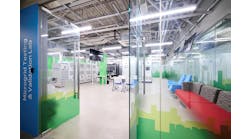Perspective: Can We Solve the AI Data Center Power Crisis with Microgrids?
President Trump announced a $500 billion private sector investment in the nation’s Artificial Intelligence (AI) infrastructure last month. The investment will come from The Stargate Project, a joint venture between OpenAI, SoftBank, Oracle and MGX, which intends to build 20 new AI data centers in the U.S in the next four to five years.
The Stargate Project committed $100 billion for immediate deployment and construction has already begun on its first data center in Texas. At approximately a half a million square feet each, the partners say these new facilities will cement America’s leadership in AI, create jobs and stimulate economic growth.
Stargate is not the only game in town, either. Microsoft is expected to invest $80 billion in AI data center development in 2025, with Google, AWS and Meta also spending big.
While all this investment in AI infrastructure is certainly exciting, experts say there’s one lingering question that’s yet to be answered and it’s a big one: How are we going to power all these AI data centers?
This will be one of the many questions tackled during Microgrid Knowledge’s annual conference, which will be held in Texas April 15-17 at the Sheraton Dallas.
“Powering Data Centers: Collaborative Microgrid Solutions for a Growing Market” will be one of the key sessions on April 16.
Industry experts will gather to discuss how private entities, developers and utilities can work together to deploy microgrids and distributed energy technologies that address the data center industry’s power needs. The panel will share solutions, technologies and strategies that will favorably position data centers in the energy queue.
In advance of this session, we sat down with two microgrid experts to learn more about the challenges facing the data center industry and how microgrids can address the sector’s growing energy needs.
We spoke with Michael Stadler, co-founder and CTO of Xendee, a company that develops software for the design and operation of microgrids and EV fast chargers.
We also spoke with Nina Sadighi, founder of Eradeh Power Consulting, a power engineering services company. Sadighi will be one of the featured panelists at the Microgrid Knowledge Conference’s session on powering data centers. She will be joined by session chair Samantha Reifer from Scale Microgrids, Elham Akhavan of Wood Mackenzie, and Michael Carney of Baker Hughes.
Here’s what Stadler and Sadighi had to say:
1. The data center industry is growing rapidly. What are the critical challenges facing the sector as it expands?
Michael Stadler, Xendee:
It’s the power consumption. Data centers need a lot of power and utilities are challenged to provide it in time – they can’t keep up with the pace of data center growth. What we’ve seen with our clients and partners is that it can take years to get a new utility interconnection, so the question really becomes what are we going to do about this now?
There are a lot of ideas floating around, like co-locating generation with data centers, firing nuclear energy generators like Three Mile Island back up, building small nuclear reactors (SMR) and the like. But it will take longer than we think to get these reactors on site. We need a solution now.
Nina Sadighi, Eradeh Power Consulting:
The most critical challenge is in Machine Learning (ML) Data Centers. Traditional data centers host server clusters where tens of thousands of workloads run with uncorrelated power profiles. In contrast, large-scale, batch-synchronized ML training workloads follow distinct power usage patterns. These new usage conditions make it increasingly difficult to maintain the reliability and availability of ML infrastructure. The peak power usage of these workloads can approach the total rated power of the underlying IT equipment, making power oversubscription significantly more challenging.
Additionally, power consumption fluctuates much more sharply between idle and peak levels because a few large ML workloads now dominate the cluster’s power usage. These fluctuations occur when workloads start, complete, pause, resume, or get rescheduled. Even during normal operation, power usage can vary due to alternating compute- and networking-intensive phases within a training step. Depending on workload characteristics, these inter- and intra-job power fluctuations can happen frequently, potentially impacting the functionality, performance, and reliability of the data center infrastructure.
2. How can microgrids and other distributed energy technologies address the challenges facing the data center market?
Sadighi:
A microgrid essentially functions as a small-scale power plant. A utility-scale microgrid integrates large gas engine generators, gas turbines, or SMRs to help address the challenges we are facing. By integrating gas engines, turbines, or SMRs, a microgrid provides a stable and dispatchable power source.
In addition, we can enhance energy efficiency with waste heat recovery and optimized power usage. Furthermore, a microgrid improves energy resilience by enabling island mode operation, allowing critical facilities to remain powered during grid disruptions.
This is particularly valuable for data centers, industrial facilities and other high-reliability applications that require uninterrupted power. By combining multiple generation sources with advanced microgrid control systems, operators can dynamically balance load demand, integrate renewables, and reduce reliance on centralized grids, ensuring both reliability and sustainability.
Stadler:
The flexibility of microgrids is the most important thing. They allow you to connect any kind of energy resource, from combined heat and power (CHP) to gas generators and SMRs. You have complete flexibility for how you set the system up. I think data centers will be receptive to building microgrids where you have more reliance on on-site technologies.
Data centers really have three options to address their power needs. One: they can do nothing and wait until the utility is ready, which is the worst case. It won't happen quickly and it’s most expensive way of solving the problem. Two: They can wait for on-site reactors to become commercially available, but that solution is very expensive and probably 10 years away. Three: Build a microgrid now and plan your power generation out in the most efficient way based on what’s available and affordable today. Build on-site generation with gas generators or renewables if they have the space. Then, when new technologies become available or existing technologies get cheaper, you can augment your system because of the microgrid’s flexibility.
The Microgrid Knowledge Conference will cover many applications of microgrids in the commercial, industrial and mission-critical sectors. Check out the full agenda here.

Kathy Hitchens
Kathy Hitchens has been writing professionally for more than 30 years. She focuses on the renewable energy, electric vehicle, utility, data center, and financial services sectors. Kathy has a BFA from the University of Arizona and a MBA from the University of Denver.





